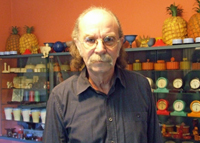Chief Agent Calling
10 Most Wanted is pleased to have appointed its first Chief Agent. Variously known as Ian15.mdx and Ian Holdsworth, he has sourced 15 separate pieces of information about objects in the MoDiP collection which we knew we wanted to find out. He has also contributed masses more contextual information - a stellar performance. Once you become a Chief Agent you have the opportunity to support HQ staff and Ian has accepted the invitation to write a blog. We hope he will also enjoy an extra-large slice of cake at the 10 Most Wanted get-together when the summer arrives.
This shows Ian standing in front a selection of objects from his private collection.

Ian's blog
Twelve years ago I needed to know something about a 1920s product. I wrote a one-page web site that contained a question and my phone number. Three years passed, and then one day I got a phone-call. An elderly lady said, I read your web site. I know the answer to your question.
People that deal with products need correct, factual information to describe them. It is possible that someone ‘out there’ can provide what information is missing. 10most has gone some way in testing a method to enable this to happen.
I have engaged with the project in two ways, by not using, then using, Facebook. Not using Facebook means emailing a 10most staff member to put up text and images on your behalf, a rather cumbersome and at times slow process. Using Facebook enables fluent posting of materials, but it is, as yet, not a legal requirement of being human to have a Facebook account, and so not everyone has one. Used in the 10most context, Facebook provides a structured communications medium that allows information to be collated in a logical way.
I have been able to help answer some of the questions posed. I am fortunate in having over thirty years of experience in handling old plastics, and enough experience of research from my university teaching days, to either know or find out some of the answers. But this kind of historical research is a limited field. Few people have engaged with it and there is only a small bibliographical base. So it is not really surprising that the number of 10most participants has remained in double figures. However, using a pragmatic judgement, much more is now known about some of the products than before the project was initiated. That has to demonstrate success, and the considerable potential for using this methodology in other situations.
Ian Holdsworth


 #10
#10 #10;</body></html>" />
#10;</body></html>" />

